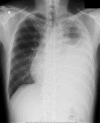Long-lasting response to crizotinib in brain metastases due to EML4-ALK-rearranged non-small-cell lung cancer
- PMID: 24022905
- PMCID: PMC3794239
- DOI: 10.1136/bcr-2013-200867
Long-lasting response to crizotinib in brain metastases due to EML4-ALK-rearranged non-small-cell lung cancer
Abstract
Anaplastic lymphoma kinase (ALK) rearranged non-small-cell lung cancer (NSCLC) is highly responsive to crizotinib, an oral ATP-competitive selective inhibitor of ALK. However, crizotinib exhibits extremely poor blood-brain barrier penetration; therefore, it is considered to play a limited role in the treatment of brain metastases. We present a case of a 50-year-old man with a diagnosis of ALK-rearranged NSCLC with brain metastasis and malignant pleural effusion. Despite the several systemic chemotherapy regimens and whole brain radiotherapy, brain metastasis was refractory; therefore, crizotinib was initiated. A CT scan showed a slight reduction in the brain metastasis and no change in intrathoracic disease 17 weeks after initiating crizotinib. Moreover, CT obtained 12 months after crizotinib treatment revealed brain metastasis without progression. To our knowledge, the present case is the second report of crizotinib-responsive brain metastases due to echinoderm microtubule-associated protein-like 4-ALK (EML4-ALK)-rearranged NSCLC.
Figures



Similar articles
-
Safety and activity of alectinib against systemic disease and brain metastases in patients with crizotinib-resistant ALK-rearranged non-small-cell lung cancer (AF-002JG): results from the dose-finding portion of a phase 1/2 study.Lancet Oncol. 2014 Sep;15(10):1119-28. doi: 10.1016/S1470-2045(14)70362-6. Epub 2014 Aug 18. Lancet Oncol. 2014. PMID: 25153538 Clinical Trial.
-
Durable brain response with pulse-dose crizotinib and ceritinib in ALK-positive non-small cell lung cancer compared with brain radiotherapy.J Clin Neurosci. 2016 Apr;26:46-9. doi: 10.1016/j.jocn.2015.05.068. Epub 2015 Dec 8. J Clin Neurosci. 2016. PMID: 26677785
-
ALK inhibitors in the treatment of advanced NSCLC.Cancer Treat Rev. 2014 Mar;40(2):300-6. doi: 10.1016/j.ctrv.2013.07.002. Epub 2013 Aug 7. Cancer Treat Rev. 2014. PMID: 23931927 Review.
-
Long-lasting response to third-line crizotinib treatment in a patient with non-small cell lung cancer with brain metastases and poor performance status.Thorac Cancer. 2016 Sep;7(5):619-622. doi: 10.1111/1759-7714.12383. Epub 2016 Aug 12. Thorac Cancer. 2016. PMID: 27766783 Free PMC article.
-
ALK inhibitors: a new targeted therapy in the treatment of advanced NSCLC.Target Oncol. 2013 Mar;8(1):55-67. doi: 10.1007/s11523-012-0250-9. Epub 2013 Jan 17. Target Oncol. 2013. PMID: 23325296 Review.
Cited by
-
Success of Crizotinib Combined with Whole-Brain Radiotherapy for Brain Metastases in a Patient with Anaplastic Lymphoma Kinase Rearrangement-Positive Non-Small-Cell Lung Cancer.Case Rep Oncol. 2018 Nov 29;11(3):777-783. doi: 10.1159/000492150. eCollection 2018 Sep-Dec. Case Rep Oncol. 2018. PMID: 30627092 Free PMC article.
-
Real-world outcomes in patients with ALK-positive non-small cell lung cancer treated with crizotinib.Curr Oncol. 2018 Feb;25(1):e40-e49. doi: 10.3747/co.25.3723. Epub 2018 Feb 28. Curr Oncol. 2018. PMID: 29507494 Free PMC article.
-
ALK inhibitors in non-small cell lung cancer: crizotinib and beyond.Clin Adv Hematol Oncol. 2014 Jul;12(7):429-39. Clin Adv Hematol Oncol. 2014. PMID: 25322323 Free PMC article. Review.
-
Treatment Optimization for Brain Metastasis from Anaplastic Lymphoma Kinase Rearrangement Non-Small-Cell Lung Cancer.Oncol Res Treat. 2019;42(11):599-606. doi: 10.1159/000502755. Epub 2019 Sep 17. Oncol Res Treat. 2019. PMID: 31527380 Free PMC article. Review.
-
PF-06463922, an ALK/ROS1 Inhibitor, Overcomes Resistance to First and Second Generation ALK Inhibitors in Preclinical Models.Cancer Cell. 2015 Jul 13;28(1):70-81. doi: 10.1016/j.ccell.2015.05.010. Epub 2015 Jul 2. Cancer Cell. 2015. PMID: 26144315 Free PMC article.
References
-
- Soda M, Choi YL, Enomoto M, et al. Identification of the transforming EML4-ALK fusion gene in non-small-cell lung cancer. Nature 2007;2013:561–6 - PubMed
-
- Takeuchi K, Choi YL, Soda M, et al. Multiplex reverse transcription-PCR screening for EML4-ALK fusion transcripts. Clin Cancer Res 2008;2013:6618–24 - PubMed
-
- Costa DB, Kobayashi S, Pandya SS, et al. CSF concentration of the anaplastic lymphoma kinase inhibitor crizotinib. J Clin Oncol 2011;2013:e443–5 - PubMed
-
- Jackman DM, Holmes AJ, Lindeman N, et al. Response and resistance in a non-small-cell lung cancer patient with an epidermal growth factor receptor mutation and leptomeningeal metastases treated with high-dose gefitinib. J Clin Oncol 2006;2013:4517–20 - PubMed
Publication types
MeSH terms
Substances
LinkOut - more resources
Full Text Sources
Other Literature Sources
Medical
Miscellaneous
